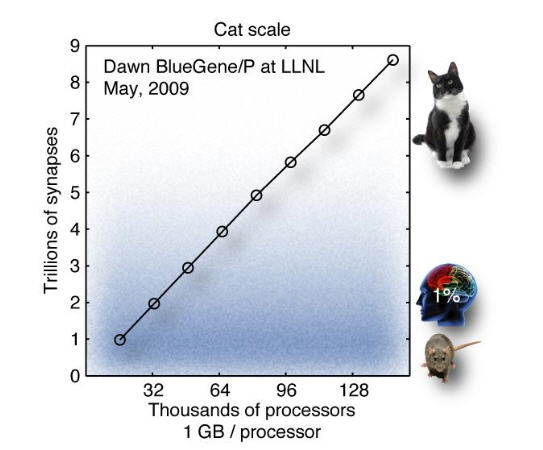IBM makes progress toward 'thinking' computing system

IBM said Wednesday that it is making progress toward cooking up a computer system that emulates the human brain and simulates abilities for sensation, perception, interaction and cognition. The end goal: Create a computing system that thinks like the human brain.
In addition, IBM announced that this "large-scale cortical simulation" and the algorithm behind it rivals the brain's power, energy consumption and size.
A new algorithm, dubbed Blue Matter, was developed with Stanford University and maps and measures all the connections in a brain. Blue Matter rides on IBM's Blue Gene supercomputing architecture. There's still some work to do though: IBM's system thus far can emulate the brain of a cat, but that's progress over previous efforts.
Dharmendra Modha, manager of cognitive computing for IBM Research, said in a blog post:
The brain is fundamentally different from and complementary to today’s computers. The brain can exhibit awe-inspiring function of sensation, perception, action, interaction, and cognition. It can deal with ambiguity and interact with real-world, complex environments in a context-dependent fashion. And yet, it consumes less power than a light bulb and occupies less space than a 2-liter bottle of soda.
Our long-term mission is to discover and demonstrate the algorithms of the brain and deliver cool, compact cognitive computers that that complements today’s von Neumman computers and approach mammalian-scale intelligence. We are pursuing a combination of computational neuroscience, supercomputing, and nanotechnology to achieve this vision....
Cognitive computing seeks to engineer the mind by reverse engineering the brain. The mind arises from the brain, which is made up of billions of neurons that are liked by an internet like network. An emerging discipline, cognitive computing is about building the mind, by understanding the brain. It synthesizes neuroscience, computer science, psychology, philosophy, and mathematics to understand and mechanize the mental processes. Cognitive computing will lead to a universal computing platform that can handle a wide variety of spatio-temporally varying sensor streams.
IBM's aim is to figure out how to build a cognitive computing chip and "explore the computational dynamics of the brain." There are a bevy of resources available for a deeper dive, including a paper on the process and background on BlueMatter.
The company said:
To perform the first near real-time cortical simulation of the brain that exceed the scale of the cat cortex, the team built a cortical simulator that incorporates a number of innovations in computation, memory, and communication as well as sophisticated biological details from neurophysiology and neuroanatomy. This scientific tool, akin to a linear accelerator or an electron microscope, is a critical instrument used to test hypotheses of brain structure, dynamics and function. The simulation was performed using the cortical simulator on Lawrence Livermore National Lab’s Dawn Blue Gene/P supercomputer with 147,456 CPUs and 144 terabytes of main memory.
As an observer, it's hard not to think that these developments are interesting---even if they can only simulate a cat for now. However, if it weren't for those Terminator movies I'd be more enthusiastic. Only half kidding there folks. Something about a computer that thinks like a brain makes me nervous.
When will it be possible to emulate the human brain? Sometime around 2018 assuming Moore's Law holds.
